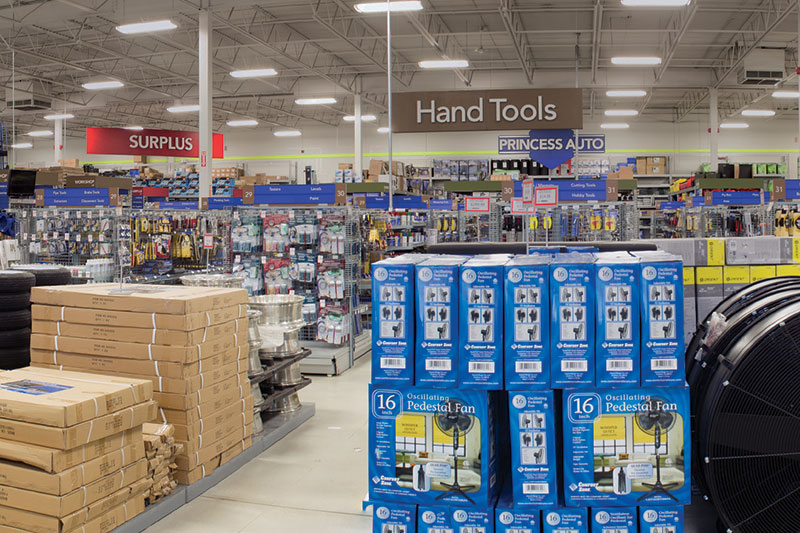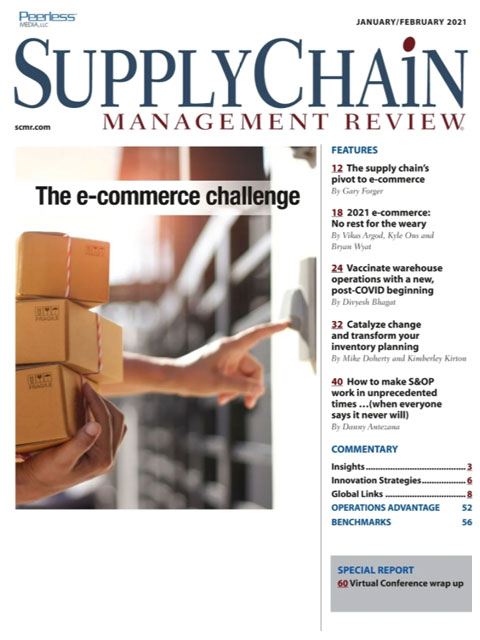Sorry, but your login has failed. Please recheck your login information and resubmit. If your subscription has expired, renew here.
January-February 2021
This morning, I turned on the television and watched the first stretch-wrapped pallets of the just-authorized vaccine being loaded onto a truck at a Pfizer plant in Michigan. From there, the pallets were headed to FedEx’s logistics hub in Memphis where they would be delivered to 153 locations across the 50 states. The event was both historic and mundane: Historic in that the shipments represent the hope of a nation that in the coming months, we’ll begin to put 2020—and COVID—in the rearview mirror; mundane in that this is a scene repeated millions of times a day, without fanfare, in plants and distribution centers across the country. Two of… Browse this issue archive.Need Help? Contact customer service 847-559-7581 More options
In business, the only constant is change. Given the complexity, connectedness and immediacy of today’s modern world, it’s safe to say that you, and your organization for that matter, need to become very good at change. Sure, we’ve attached fancy and modern names to it—pivot, for example—but the bottom line is we all need to excel at changing our minds, our worldviews and work and personal habits.
But change is hard. To highlight just how hard, consider the difficulty people have in changing their habits when faced with a life-threatening situation—people who require coronary-artery bypass surgery. After the surgery, patients are told that they need to change their lifestyle to maintain their health—stop smoking, stop drinking, stop overeating, start exercising and reduce stress. Yet, study after study confirms the dismal results—within two years of the surgery 90% have not changed their lifestyle. Those are odds of about nine to one against you making the change, even in a life and death situation.
It’s no surprise then that business change has similar odds. After all, we’ve eventually realized that business change is really about people—the ability to change not only our own minds, but also help others change theirs as well. Joe Jackman, in his excellent book, “The Reinventionist Mindset,” speaking about business transformation and reinvention summed it up perfectly when he wrote: “Change is a human endeavor with a business consequence.” Business change and transformation is about people and, essentially, the inner workings of the brain.
This article outlines the approach and learnings that Princess Auto Ltd used to completely transform how it plans and manages the supply chain and the flow of inventory from supplier to consumer. It will provide details on how this 87-year-old company was able to change the collective thinking, or mental model, of the company utilizing many of the principles and ideas outlined in “The Catalyst,” a new book about the process of change by Jonah Berger.

This complete article is available to subscribers only.
Log in now for full access or start your PLUS+ subscription for instant access.
SC
MR
Sorry, but your login has failed. Please recheck your login information and resubmit. If your subscription has expired, renew here.
January-February 2021
This morning, I turned on the television and watched the first stretch-wrapped pallets of the just-authorized vaccine being loaded onto a truck at a Pfizer plant in Michigan. From there, the pallets were headed to… Browse this issue archive. Access your online digital edition. Download a PDF file of the January-February 2021 issue.In business, the only constant is change. Given the complexity, connectedness and immediacy of today’s modern world, it’s safe to say that you, and your organization for that matter, need to become very good at change. Sure, we’ve attached fancy and modern names to it—pivot, for example—but the bottom line is we all need to excel at changing our minds, our worldviews and work and personal habits.
But change is hard. To highlight just how hard, consider the difficulty people have in changing their habits when faced with a life-threatening situation—people who require coronary-artery bypass surgery. After the surgery, patients are told that they need to change their lifestyle to maintain their health—stop smoking, stop drinking, stop overeating, start exercising and reduce stress. Yet, study after study confirms the dismal results—within two years of the surgery 90% have not changed their lifestyle. Those are odds of about nine to one against you making the change, even in a life and death situation.
It’s no surprise then that business change has similar odds. After all, we’ve eventually realized that business change is really about people—the ability to change not only our own minds, but also help others change theirs as well. Joe Jackman, in his excellent book, “The Reinventionist Mindset,” speaking about business transformation and reinvention summed it up perfectly when he wrote: “Change is a human endeavor with a business consequence.” Business change and transformation is about people and, essentially, the inner workings of the brain.
This article outlines the approach and learnings that Princess Auto Ltd used to completely transform how it plans and manages the supply chain and the flow of inventory from supplier to consumer. It will provide details on how this 87-year-old company was able to change the collective thinking, or mental model, of the company utilizing many of the principles and ideas outlined in “The Catalyst,” a new book about the process of change by Jonah Berger.
SC
MR


Latest Supply Chain News
- Few executives believe their supply chains can respond quickly to disruptions
- Technology’s role in mending supply chain fragility after recent disruptions
- Tech investments bring revenue increases, survey finds
- Survey reveals strategies for addressing supply chain, logistics labor shortages
- Israel, Ukraine aid package to increase pressure on aerospace and defense supply chains
- More News
Latest Podcast

 Explore
Explore
Business Management News
- Few executives believe their supply chains can respond quickly to disruptions
- Technology’s role in mending supply chain fragility after recent disruptions
- Survey reveals strategies for addressing supply chain, logistics labor shortages
- How CPG brands can deliver on supplier diversity promises
- How S&OP provides the answer to in-demand products
- AI, virtual reality is bringing experiential learning into the modern age
- More Business Management
Latest Business Management Resources

Subscribe

Supply Chain Management Review delivers the best industry content.

Editors’ Picks






